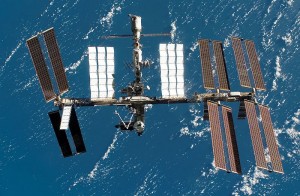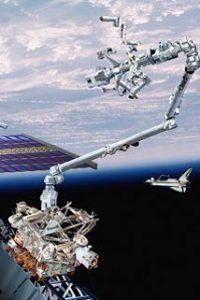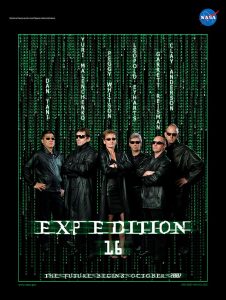Expedition 15 Arrives on Soyuz TMA-10
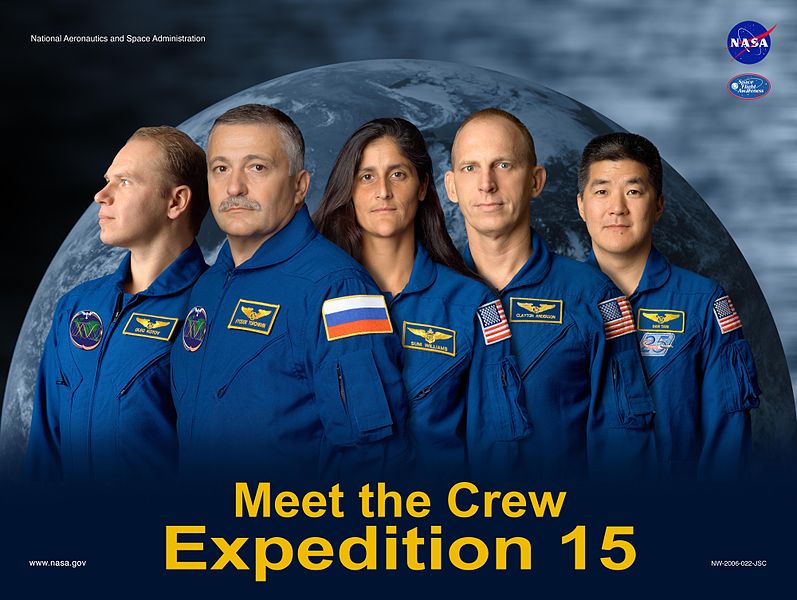
Docking of Soyuz TMA-10

On April 7, 2007, Soyuz TMA-10 launched with Expedition 15 Commander Fyodor Yurchikhin and Flight Engineer Oleg Kotov. Also on board was another spaceflight participant, Charles Simonyi, who was a co-founder and software developer for Microsoft and founder of Intentional Software Corp., a software engineering firm. The Soyuz docked with the International Space Station on April 9.
Yurchikhin had referred to Sunita Williams as “our Suni” in interviews because she would be staying when the Expedition 14 crew returned home. He was happy to have her three months’ worth of experience on the station to answer any questions that they might have forgotten to ask the Expedition 14 crew during the 10-day handover routine. She transferred her seat from Soyuz TMA-9 to Soyuz TMA-10 and Simonyi transferred his seat to Soyuz TMA-9. During the handover period (April 16), she also ran on the treadmill as part of the Boston Marathon, finishing the first full marathon run in space with a time of just under 4 hours 24 minutes.
During a group meal, Simonyi produced some gourmet French meat to share with the crew. He also conducted a radiation study for the Hungarian Space Agency, took swab samples for the European Space Agency, and recorded his reactions to spaceflight. He departed with the Expedition 14 crew on April 21, 2007, describing his last sight of the International Space Station as “bittersweet”.
Expedition 15
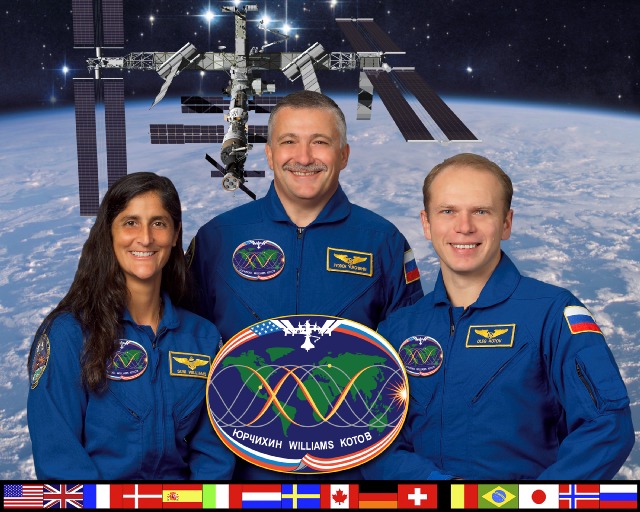
The first few days alone on the station were dominated by medical and emergency drills and other orientation tasks for the new crew. Sunita Williams thought it was different to have two Russians on board and did her best with the Russian language, but sometimes the two Russians would ask her to repeat in English. Russian flight controllers test-fired two maneuvering thrusters on the Russian side of the station in late April, raising the station’s orbit in preparation for the arrival of the next Progress and STS-117.
Sunita Williams worked with the SPHERES satellites and the Elastic Memory Composite Hinge, which tested a new composite hinge designed to be stronger and lighter than comparable hinges already used in space. Maintenance included removing a docking mechanism from Progress M-59 for return to Earth on STS-117, a check of communications systems and work on Zarya’s battery temperature sensors. On May 9, they took a light day in memory of the end of World War II, called “Victory Day” in Russia.
In April 2007, NASA administrator Michael Griffin announced plans to include the International Space Station in budget planning through 2020. This reversed an earlier NASA plan to fund the ISS only through 2016. He said of the matter, “I doubt [the International Space Station] will suddenly turn into a pumpkin in 2016.”
May 2007 began on a sad note when Sunita Williams heard of the passing of Mercury astronaut Wally Schirra. She praised the dedication of all the individuals who had worked on the early American and Russian space programs and expressed the hope that the space-faring nations involved in the space station would continue to develop their partnership for future ventures.
Progress M-60 docked to the station on May 15, 2007. Soon afterwards, Sunita Williams was informed that she would be returning home on STS-117, a little earlier than planned. Clayton Anderson would be arriving on the same mission to join the Expedition crew and kidded Williams about Expedition 14’s Michael Lopez-Alegria being involved in a plot to prevent Williams from besting his duration record.
While beginning preparations to return home, Williams also took care of maintenance on the exercise equipment and made updates on the laptop software. She worked with the Capillary Flow Experiment, which studied the behavior of fluids and capillary flows in complex-shaped containers, collected water samples from the space station’s upgraded water supply, and prepared blood and urine samples for return to Earth. Williams experimented with the mashed potatoes by adding olive oil and cheese and enjoyed the coffee and cream in one of the individualized “bonus container” meals she had been saving as an improvement over plain black coffee. She also got Oleg Kotov to try a peanut butter and jelly tortilla. He was a little dubious at first because peanut butter isn’t as common in Russia as it is in the U.S., but he ended up liking it. She commented in an article for NASA’s website that she was looking forward to a chance to take a real shower and also visit her favorite diners. When she got some free time, she did a lot of Earth-gazing and developed a sympathy for the Apollo astronauts who orbited the Moon but never landed.
Meanwhile, Kotov and Yurchikhin finished preparations for Progress M-59’s departure and closed the hatch on May 23. They also began preparations for an EVA planned for May 30.
Coverage of the Expedition 15 Spacewalks
Expedition 15 Stage EVA #1

The first Stage EVA of Expedition 15 was delayed by 45 minutes while the crew and controllers handled troubleshooting on a communications problem. Finally, Yurchikhin and Kotov began their spacewalk by exiting through Pirs on May 30, 2007. They collected tools and proceeded to the Strela-2 crane, where they installed an extension on the Strela boom to increase its length. Kotov rode the crane extension with Yurchikhin cranking a handle to maneuver it to an adapter stowage rack on PMA-3. This was a rack that Sunita Williams and Robert Curbeam had installed on one of the spacewalks of STS-116 to hold seventeen micro-meteoroid debris panels and the crew referred to it as the “Christmas tree”. The end of the crane locked onto a grapple fixture. Kotov took hold of the “Christmas tree” and Yurchikhin maneuvered the Strela crane to Zvezda’s ram. Then, Yurchikhin made his way to the Zvezda and the two cosmonauts secured the Strela to a grapple fixture.
Before dealing with the adapter stowage rack, the EVA cosmonauts made their way to Zvezda’s cone and rerouted a cable for the station’s GPS, which would assist the arrival of the European Space Agency’s ATV. They returned to the stowage rack and deployed a bundle of five debris panels between Zvezda’s wider and narrower sections. Sunita Williams kidded that they were now the “Christmas Tree Gang” and the two EVA cosmonauts returned to Pirs with an EVA duration of 5 hours and 25 minutes. The station crew worked on maintaining the Orlan suits and recharging their batteries the next day.
Expedition 15 Stage EVA #2
On June 6, 2007, Yurchikhin and Kotov began their second spacewalk by exiting through Pirs in Orlan suits. They began by installing the Biorisk experiment sponsored by the Russians, which studied the effects of the space environment on microorganisms, on the exterior of Pirs. They proceeded to the exterior of Zarya, where they installed the first of two sections of Ethernet cable for the computer network. During the cable installation, they noticed a dent that they described as a “bullet hole.” It was evidence of meteorite damage to the station. The second would be installed on a later spacewalk. Moving on to the Zvezda service module, they removed one of the two remaining SMDP bundles from the “Christmas Tree” bundle, opened it up and installed the micro-meteoroid debris panels to Zarya’s exterior. They repeated the process with the remaining SMDP bundle. With that completed, Yurchikhin and Kotov returned to Pirs with an EVA duration of 5 hours and 37 minutes.
Afterward, the crew settled into final preparations for the arrival of STS-117. Delays caused the launch schedule to be pushed back and plans to retire the Atlantis shuttle to cannibalize for parts were scrubbed. NASA added $719 million dollars to the contract with the Russians to pay for American seats on Soyuz flights.

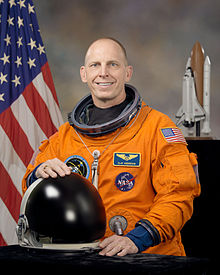
As Clayton Anderson settled in for the long haul, the cosmonauts were still busy troubleshooting the six computer that had crashed during STS-117. They had set up jumper cables to bypass a secondary power switch. When the cables were removed, the primary computers refused to boot and the systems controlled by the primary computers ran on two backups until the problem was traced to a buildup of condensation in a power-monitoring box and corrosion in two connector pins. When the original device was replaced by a new unit, condensation and microbial deposits were discovered on a wall behind it. An old book was placed between the box and wall as an insulation layer. The six affected computers were successfully brought back online. Both the Russians and Americans updated the software on their respective computer systems with the American updates including new control software for the Node-2, Harmony, Columbus and Kibo modules that would be delivered in the coming year.
Stage EVA #3
Before the next Stage EVA, the station was rotated by 180 degrees to position Destiny’s ram at the station’s wake. This would allow for safer disposal of large equipment that would be jettisoned during the EVA. On July 23, Yurchikhin and Anderson exited through Quest and gathered their tools. They moved a stanchion for a TV camera from a storage pallet to the nadir surface of the P1 Truss. Anderson reconfigured an S-Ban Antenna Assembly’s power supply and then mounted a foot restraint on Canadarm2. Yurchikhin made his way to the Mobile Transporter to replace a Remote Power Controller Module that would provide a backup supply of power. Working inside the space station, Kotov moved Anderson along the truss as the two EVA astronauts removed a Flight Releasable Attachment Module and jettisoned it. They also detached cables from the Early Ammonia System, which would have provided an emergency supply of ammonia to the temporary cooling system if it was needed. With the permanent cooling system in place and the space needed for moving the P6 Truss to its permanent location, Anderson could jettison the EAS, which was expected to remain in orbit for about eleven months. For their final scheduled task, they cleaned Unity’s CBM in preparation for work scheduled for STS-120.
For their get-ahead tasks, they moved an equipment bag from P6 to the Z1 truss, removed a faulty GPS antenna from the S0 truss, and released bolts on two fluid trays on S0 that would be relocated during STS-120. The two EVA astronauts returned to Quest with an EVA duration of 7 hours 41 minutes. The International Space Station was returned to its original attitude.

Once STS-118 departed, the crew began to return to their usual routine. Anderson’s duties included a dietary study that involved keeping a record of his diet and providing samples to measure vitamin-D content. He also wore a special watch that monitored his daily sleep/wake patterns as part of a study that would hopefully help people with disruptive sleep patterns. Other experiments included a controlled combustion study and a look at the growth patterns of plants and worms.
As part of preparations for the arrival of STS-120 in late October, Anderson used Canadarm2 to grip PMA-3, which was used by the Space Shuttle as a docking mechanism. Yurchikhin commanded the Unity’s port CBM to release its hold on PMA-3 and Anderson moved the PMA into position at Unity’s nadir CBM. Yurchikhin ordered Unity’s docking mechanism to close and hold it in place. The move had been made so that STS-120 could temporarily install the Harmony module in a position where Canadarm2 could be used to install PMA-2 on Harmony’s port and then move Harmony to Destiny’s ram.
Once this was done, the maintenance routine included updating software and hardware for the American computer system and replacing outdated EVA support equipment in Zvezda and Pirs. Yurchikhin and Kotov were beginning preparations for the end of Expedition 15 and their return home. On September 27, the crew members moved Soyuz TMA-10 from Zarya’s nadir to Zvezda’s wake to clear the way for the docking of Soyuz TMA-11 and Expedition 16 on October 10.
In Destiny, Anderson assisted with tests of the American Oxygen Generation System that could support crews of six people even if the Elektron generator went down for good. He left it running at 50% power while controllers monitored its performance.
On October 2, the Mobile Transporter/Mobile Bus System combination had to be moved to the port side of the space station. Canadarm2 would be getting a workout when the P6 Truss was moved from its current position on the Z1 Truss to its permanent location on the port side of the International Space Station.
On October 4, 2007, the crew paused to remember the 50th anniversary of the launch of Sputnik 1 and the start of the Space Age. In the week before the launch of Expedition 16, the crew finished up remaining experiments and prepared for the arrival of Soyuz TMA-11.
Inside the Unity Node
The Unity node connects the working and living areas of the International Space Station. Here’s a look inside.
More About The International Space Station
[simple-rss feed=”http://rest.ebay.com/epn/v1/find/item.rss?keyword=International+Space+Station&categoryId1=267&sortOrder=BestMatch&programid=1&campaignid=5337337555&toolid=10039&listingType1=All&lgeo=1&feedType=rss” limit=5]

